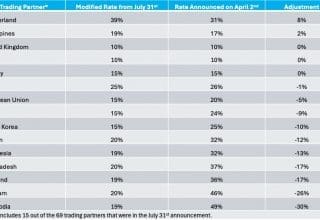Tariffs ranging from 10% to 41% are set to take effect today for multiple countries. This comes months after the world was catapulted into a spiraling trade war, following President Donald Trump’s “Liberation Day” announcement on April 2. The looming threat of tariffs has created uncertainty for businesses across nearly every industry, as deadline after deadline for implementing tariffs has been repeatedly pushed back in an attempt to broker trade deals.
The tariffs that went into effect on Aug. 7 reflect a change in the rate from what was threatened initially during the “Liberation Day” announcement.
“From the April 2 to the July 31 announcements, the average tariff rate among the included trading partners declined from 25% to 19%,” Joseph Harris, fiscal policy analyst for the John Locke Foundation, told the Carolina Journal. “Among the most significant rate reductions were for Cambodia, 49% to 19%, and Vietnam, 46% to 20%. On the other hand, Switzerland received the largest rate increase, 31% to 39%.”
In the July 31 announcement, 69 trading partners were included. Eight of these partners saw no change in their tariff rates from the April 2 announcement. Among the remaining 61 partners whose rates were adjusted, 19 experienced increases while 42 saw decreases. The average proposed tariff rate for all 69 countries dropped from 25% in April to 19% in the latest announcement. The new rates range from a low of 10% — applicable to the United Kingdom, Brazil, and the Falkland Islands — to a high of 41% for Syria.
“The United Kingdom, Brazil, and the Falkland Islands are subject to the lowest tariff rate of 10% in the July 31 schedule, placing them well below the average for all countries,” continued Harris. “Although many of the July 31 tariff rates are lower than those announced in April, they still represent added trade costs that could result in higher prices for certain goods if those costs are passed along to consumers.”
India is set to face an additional 25% tariff, for a combined 50% tariff, which is set to take effect in three weeks, according to the Washington Post. According to the executive order signed by Trump on Aug. 6, the additional tariff is in response to India’s imports of Russian oil and the Russian invasion of Ukraine.
In addition to the individual tariffs for each nation, there is already a 50% tariff on steel and aluminum, which went into effect on June 4, as well as a 25% tariff on automobiles and automobile parts.
This is already impacting the industry and North Carolina manufacturers as General Motors recently announced a net tariff impact of $1.1 billion in the second quarter of the fiscal year and estimated an annual impact of $4-5 billion due to new tariffs, according to GM. GM manufactures vehicles for private and commercial use. GM Defense, a subsidiary of GM, also manufactures vehicles for the Department of Defense. GM Defense opened a production facility in Concord in 2021.
Despite the overall reduction in average tariff rates since April, today’s implementation still marks a substantial escalation in trade barriers for many countries. Businesses and consumers may soon feel the ripple effects, as these added costs filter through global supply chains and influence prices.
The post Trump tariffs to take effect first appeared on Carolina Journal.
The post Trump tariffs to take effect appeared first on First In Freedom Daily.
Click this link for the original source of this article.
Author: Katherine Zehnder
This content is courtesy of, and owned and copyrighted by, https://firstinfreedomdaily.com and its author. This content is made available by use of the public RSS feed offered by the host site and is used for educational purposes only. If you are the author or represent the host site and would like this content removed now and in the future, please contact USSANews.com using the email address in the Contact page found in the website menu.








